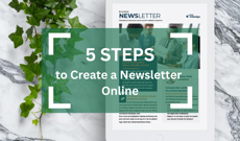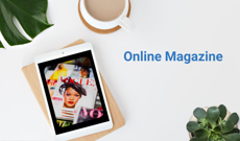Our flipbook catalog is a beautiful representation of our brand.
Catalogs are an irreplaceable tool both for marketing and sales. They help businesses to showcase their products, and customers—to navigate through product ranges and make informed decisions. Since they first appeared, product catalogs have come a long way from printed booklets designed for mail orders to, more recently, their digital counterparts. And while a lot of companies still prefer the tangible reliability of hard copy catalogs, many have chosen to go digital.
But not every digital catalog format is as efficient as the next one. In this article, using the case of one of our clients, Food Huggers, as an example, we’re going to give you seven reasons why the digital flipbook format is the format you should go for when putting your product catalog online.
Who Are Food Huggers?
Food Huggers is a company that designs food-saving products to replace single-use plastics with high-quality reusable alternatives, all the while keeping your food fresh longer. By providing simple tools for reducing waste, they help make sustainable habits easy, convenient, and fun. Food Huggers create product catalogs with FlippingBook to keep retailers and wholesale customers up-to-date on the latest additions to their product line.
Print Vs. Digital
Many companies still print their catalogs out, in some industries more than in others. And it’s easy to see why. Printed catalogs with their glossy pages, bright colors, and tactility offer an experience that not many digital formats can rival—or so some people think.
However, in the last couple of decades, the world around us has pretty much moved online. You can have a whole business on the web without having to ever meet your customers. And, on their part, customers have grown accustomed to shopping and looking for anything they need online.
So keeping your catalogs in print only? It can really hold you back.
We decided we didn’t really need a printed version of our catalog. A digital version would be more convenient while also meeting our sustainability goals.
7 Reasons to Turn Your Catalog Into an Online Flipbook
There are several ways of creating a digital product catalog, the most obvious and ubiquitous of them is making a PDF. But even though it’s the solution that probably comes to mind first, there are other, more advanced options to consider.
Online flipbooks are one of these options and the one we’re going to focus on in this article. Firstly, because it’s actually very easy to make an online flipbook—all you have to do is convert a PDF via a flipbook maker, so no steep learning curves here. And secondly, because, when it comes to product catalogs, the flipbook format is superior to all other formats. Here are the seven reasons why:
#1 Look and feel
As we’ve said before, if there is one thing printed catalogs still have going for them, it’s their look and feel. Compare scrolling down an endless PDF file and leisurely flipping through the pages of a printed catalog—the latter certainly sounds nicer.
But digital flipbooks fill that breach between the print and the digital experiences. You can flip through a flipbook catalog as easily as you would through a printed one. Its smooth, hyper-realistic page turn effect and the sound of turning pages help your customers get an authentic reading experience online and give your catalog an extra wow factor.
The ‘page-turning’ sound produced when you flip through our FlippingBook catalog is a detail we absolutely love. Viewing the catalog as a two-page spread allows you to read the online catalog as you would a physical copy. FlippingBook helps us to bring the stylish aesthetic of our products into our catalog as well.
#2 Navigation
While it can take time to find something in a printed or PDF catalog, flipbook catalogs make navigation a breeze. Text search, thumbnails, and an interactive table of contents guarantee that your customer will find the item they’re looking for in seconds.
#3 Interactivity
A table of contents is not the only thing that can be interactive in your catalog. The flipbook format allows you to sprinkle the pages of your product catalog with all kinds of engaging interactivity—videos, YouTube shorts, links, GIFs, inline and pop-up images, image galleries, lead capture forms… Interactive content will undoubtedly catch your customer’s eye but more importantly, it will let you make the most of your product presentation. Insert as many photos of an item as you need, use pop-ups to highlight its details, embed video reviews, link back directly to the cart, gather feedback through a lead form—all of this is possible with flipbook catalogs.
#4 Ease of sharing
Sharing is another thing flipbook catalogs excel at. You can only share a PDF by making your customer download it, and not everyone will be happy with this arrangement, especially if they’re using mobile data. With flipbook catalogs, sharing comes in all shapes and forms.
First of all, your customer doesn’t have to download your catalog—they can view it online just by clicking the link you’ve sent them. As for the link, it can be a simple direct link to the catalog or it can lead to a certain page or even a certain paragraph in it—very handy if you need to draw your client or retailer’s attention to one particular item.
You can also share the link on social media (it will come with a neat preview), generate a QR code for easy offline sharing, or even embed your interactive product catalog directly into your website. This way, your customers can comfortably flip through it without leaving the page.
Before we found FlippingBook, we were sending our catalog as a PDF, but it wasn’t as easy to flip through as the hard copy would be. Something important was lost in that transition from print to digital.
#5 Ease of updating
Product catalogs are ever-changing by their nature. Even if there are no typos to fix, items come and go, prices change, and you need to be able to update your catalog accordingly. With printed copies, any change means reprinting—and reprinting means extra cost. With PDFs, while changing the document itself won’t cost you much, you still have to resend the file every time a new edit is introduced and hope that your retailers save the right copy.
The flipbook format makes updating easy. All you have to do is replace the PDF file in your flipbook. The second it’s replaced, the new version of your catalog is available to everyone. The main perk is—while the catalog changes, the link to it won’t.
We update our catalog multiple times a year, so it’s helpful that I can seamlessly upload a new version without having to backtrack and change the catalog link across all communications where it’s published.
#6 Analytics
While you can only guess how many printed catalogs are actually browsed and how many are just tossed straight into the trash, flipbook catalogs allow you to always be aware of how well your content performs and what items attract more attention than others. How? All user activity with online product catalogs is tracked, from views and viewers to more complicated stats, such as time spent by viewers on each page. This helps you to avoid guessing and analyze actual numbers and plan ahead with certainty.
We attended Expo West earlier this year and made sure to include our flipbook in our media kit. We were able to track how many people were visiting our site thanks to FlippingBook’s analytics feature.
#7 Sustainability
As a digital solution, flipbook catalogs are infinitely more sustainable than printed ones. Even if not all your retailers are on board with going digital, by moving at least part of your catalogs online you’ll save trees that would otherwise end up in landfills. It will also save you money which surely doesn’t hurt. If your company, like Food Huggers, cares about the environment and makes it one of its core values, flipbook catalogs are the way to go for you.
We’re, at our core, a sustainable company and we try to reduce our footprint wherever we can. FlippingBook helps make this possible by serving as a useful tool to make the digitalization of our catalog effortless.
These are seven reasons to turn your catalogs into flipbooks via FlippingBook product catalog maker. Give it a try and you’ll be able to flip through your own beautiful flipbook catalogs in no time!





